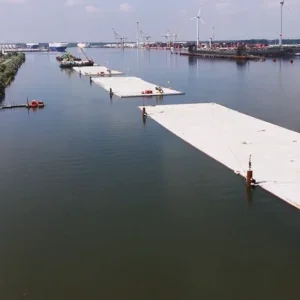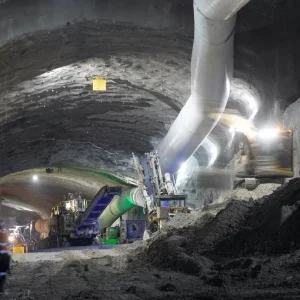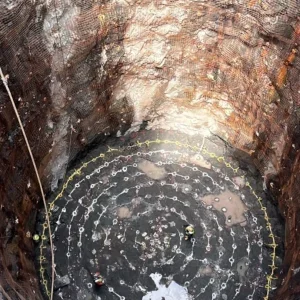The ESA project in total is worth about USD 9.3bn and is the first expansion of the New York railroad in over 100 years bringing in the Long island rail from Queens into a new terminal beneath the existing Grand Central Terminal.
The project includes 10.5 miles (17km) of tunnelling with two station caverns and a general overview of the project was presented at the BTS by Andy Thompson in January 2011.
All blasting in New York is covered by the Fire Department (FDNY) and the regulations surrounding their use are governed by several factors including the terrorist attacks in 1993 on the World Trade Center. Every stick is individually registered and contains a trace element such that if any is found elsewhere then it can be traced back to New York.
The control of ground and structural movement due to vibrations when blasting is obviously a key factor in the regulations. The target was to try and keep within limits set by the US Bureau of Surface Mines. Figure 1 shows the areas where blasting has occurred. The East River separates the soft glacial till from the Manhattan schist.
Figure 2 shows the station being built under the Grand Central Terminal with all materials, except for concrete, being brought in by train. The terminal itself is the sixth most visited building in the world with 750,000 people passing through each day. 250,000 are commuters with the other half million visiting to eat and shop. Fortunately most of the blasting was under the non-historically important train shed. To complicate matters though there are also several utility tunnels under the station.
To avoid excessive dust on the surface, water cannons are used underground to act as water curtains to remove most particles after blasting through the ventilation tunnels. Whilst vibration controls and environmental management are standard features, the focus on quality control of blasting operations is unique to New York. Licenses are not granted to anyone who is not a contractor; so for the work to be assured, the blasting is checked and re-checked by different qualified staff. The main goal was to ensure no disruption of train services.
The vibration controls were self-controlled so for the columns under the station these were kept at 50mm/sec and 12.5mm/sec for historical structures with no blasting allowed within approximately 4m of a existing column footing. 25mm/sec was used for existing steam pipes, many of which had expansion joints at, or close to, their operational limit. Structural impacts were assessed using microstrains with a review at 50 microstrains and an alert at 100 microstrains. These were converted to stresses and then checked against the allowed overstress in columns. In reality the train movements were found to impart a higher microstrain than the blasting operations albeit with a different frequency.
The existing columns were examined to see if their construction matched the as built details provided. In most cases they did not and there was over break and fractured rock on the footings due to the blasting in the original construction.
For the excavation of the shafts therefore, mechanical excavation had to be used 4m below the lowest existing footing level encountered. An expansive mortar was used to break up rock on the surface but the low Ph of 1.0 meant that safety decontamination measures such as showers and bottles of vinegar to counter the alkalinity of the mortar needed to be employed
Initially 1.3m rounds were used on a 10m wide face later increased to 2.6m with no formwork was used on the inclined shafts, only sprayed concrete.
For the environmental controls there had to be control of dust and fumes whilst blasting in an operational station and control the over air pressure. Blast doors were used to help control dust when blasting as well as ventilation to filter out the dust.
For the cavern excavation, the TBMs were driven through before then being enlarged out in sequence (see Figure 3). Roadheaders were used in the cavern to limit the number of blasts. For the removal of the pillars 3.3m rounds were used in a burn cut. Once the top headings were completed then vertical holes were drilled down to the lower TBM drives with the bench being blasted out and removed. Overbreak was minimal though some excessive overbreak did occur on the TBM tunnel enlargements.
Only two licenses for explosives are granted in New York City with Austin Powder being the main supplier with Emulex cartridges and the Nonel detonators with an 8ms delay. Double stack and triple stack blasting were attempted early in the project but single stack blasting was preferred with two or three loops and a 7ms clip in-between.
Two week look ahead schedules were produced for the railroad operator (see Figure 4) and updated every week with restrictions in place depending on location and specific time windows allocated for blasting with pre and post inspection of the surrounding station structure and rails.
No blasting was allowed in the rush hours and the largest window for blasting, inspection of vibration results and post inspection was 12 minutes.
The train schedules were altered to assist with this. A 24 hour notification was required for all blasts with a phone system direct from underground to agree with the station operator the exact time of the blast.
Some 2,364 blasts took place with only 54 misfires (2.3 per cent). About 200,000kg of explosive were used with a powder factor of 2.4kg/m3. The vibration criteria were only exceeded 35 times (1.5 per cent).
The excavation of the 55th Street ventilation facility can be seen in Figure 5. To maintain traffic flow, decking was required at the surface. Excavation then continued beneath by mechanical methods then blasting.
Test blasts were carried out at 25 per cent, 50 per cent and 100 per cent of the charge rate but in the end hoe ramming was used to excavate the plenum. Drilling for the shaft was then undertaken.
All the blasts had blast mats ensuring that they were always kept the same way round to remove the risk of debris from previous blasts being blown off. Air overpressure was limited to no more than 133dB which was achieved with low vibrations of only about 15mm/s.
The final blasting round was undertaken by blasting into the cavern below.
At present all excavation on the project has been completed, and the scheme is scheduled to open to the public in 2020.
Questions from the floor
Martin Mannott-Russell of BASF asked if electric detonators had been considered
Andy Thompson explained that they had been considered but the NYFD excluded their use.
John Moss of Mott MacDonald asked what blackouts occurred that were not part of the contract e.g. churches, schools etc.
Andy Thompson explained that this only generally occurred if there was an increase in misfires or the PPV had been exceeded. there have been no problems from neighbours during construction.
Gavin Bowyer of Minsouth asked if there were any groundwater or weather problems.
Andy Thompson replied that the schist was dry and due to previous underground work the conditions were well understood. the water in the photos was from construction. Hurricane sandy caused a problem only with staff travelling to work and explosive deliveries across a bridge that was closed. there was no inundation as experienced elsewhere.







